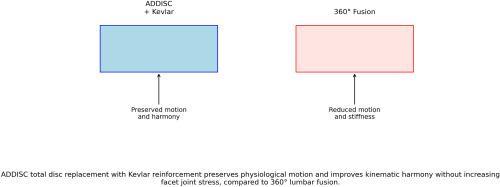Facet joint loading after Kevlar-reinforced disc replacement vs. lumbar fusion. A cadaveric model study
Q2 Medicine
引用次数: 0
Abstract
Background
Lumbar spinal fusion, while effective for degenerative disc disease, eliminates motion and may accelerate adjacent segment degeneration. Total disc replacement (TDR) with anterior annular reinforcement may offer a motion-preserving alternative.
Objective
To compare spinal kinematics and facet joint pressures between (1) total lumbar disc replacement with anterior Kevlar band reinforcement (TDR group) and (2) standard 360° lumbar fusion (fusion group) in a cadaveric model.
Methods
Six fresh-frozen human lumbar spines (L2–S1) were tested in a custom motion simulator under both surgical conditions at L4–L5. Kinematic parameters included range of motion (ROM), peak angles, and motion harmony (angle–acceleration correlation). Zygapophyseal joint pressures were measured using Tekscan sensors. Data were analyzed using repeated-measures ANOVA.
Results
The TDR group preserved significantly greater flexion (−25.7° vs −21.8°, p < 0.001) and left axial rotation (p = 0.025), while the fusion group showed greater extension (p < 0.001). TDR demonstrated superior motion harmony across all axes (p < 0.01) and better preserved ROM at adjacent levels. No significant differences in mean maximum facet joint pressures were observed (p > 0.05), though slightly higher values were noted in TDR during axial rotation.
Conclusion
Anterior annular reconstruction with Kevlar bands during total disc replacement restores near-physiological motion and improves kinematic control without increasing facet joint stress. This technique may offer a biomechanically favorable alternative to lumbar fusion.

凯夫拉增强椎间盘置换术后小关节负荷与腰椎融合。尸体模型研究
腰椎融合术虽然对退行性椎间盘疾病有效,但会消除运动,并可能加速邻近节段退变。全椎间盘置换术(TDR)与前环加固可以提供一种保持运动的选择。目的比较(1)全腰椎间盘置换术前路凯夫拉带加固(TDR组)和(2)标准360°腰椎融合术(融合组)在尸体模型中的脊柱运动学和小关节压力。方法在定制的运动模拟器中测试6根新鲜冷冻的人腰椎(L2-S1)在L4-L5两种手术条件下的运动。运动学参数包括运动范围(ROM)、峰值角和运动协调性(角-加速度相关性)。使用Tekscan传感器测量颧突关节压力。数据分析采用重复测量方差分析。结果TDR组保留了更大的屈曲(- 25.7°vs - 21.8°,p < 0.001)和左轴旋转(p = 0.025),而融合组保留了更大的伸展(p < 0.001)。TDR在所有轴上表现出优越的运动和谐(p < 0.01),并在相邻水平上更好地保存ROM。观察到平均最大关节面压力无显著差异(p > 0.05),尽管在轴向旋转时TDR值略高。结论在全椎间盘置换术中应用凯夫拉带前环重建可恢复近生理运动,改善运动控制,且不增加关节突关节应力。该技术可作为生物力学上有利的腰椎融合术替代方法。
本文章由计算机程序翻译,如有差异,请以英文原文为准。
求助全文
约1分钟内获得全文
求助全文
来源期刊

Journal of Clinical Orthopaedics and Trauma
Medicine-Orthopedics and Sports Medicine
CiteScore
4.30
自引率
0.00%
发文量
181
审稿时长
92 days
期刊介绍:
Journal of Clinical Orthopaedics and Trauma (JCOT) aims to provide its readers with the latest clinical and basic research, and informed opinions that shape today''s orthopedic practice, thereby providing an opportunity to practice evidence-based medicine. With contributions from leading clinicians and researchers around the world, we aim to be the premier journal providing an international perspective advancing knowledge of the musculoskeletal system. JCOT publishes content of value to both general orthopedic practitioners and specialists on all aspects of musculoskeletal research, diagnoses, and treatment. We accept following types of articles: • Original articles focusing on current clinical issues. • Review articles with learning value for professionals as well as students. • Research articles providing the latest in basic biological or engineering research on musculoskeletal diseases. • Regular columns by experts discussing issues affecting the field of orthopedics. • "Symposia" devoted to a single topic offering the general reader an overview of a field, but providing the specialist current in-depth information. • Video of any orthopedic surgery which is innovative and adds to present concepts. • Articles emphasizing or demonstrating a new clinical sign in the art of patient examination is also considered for publication. Contributions from anywhere in the world are welcome and considered on their merits.
 求助内容:
求助内容: 应助结果提醒方式:
应助结果提醒方式:


